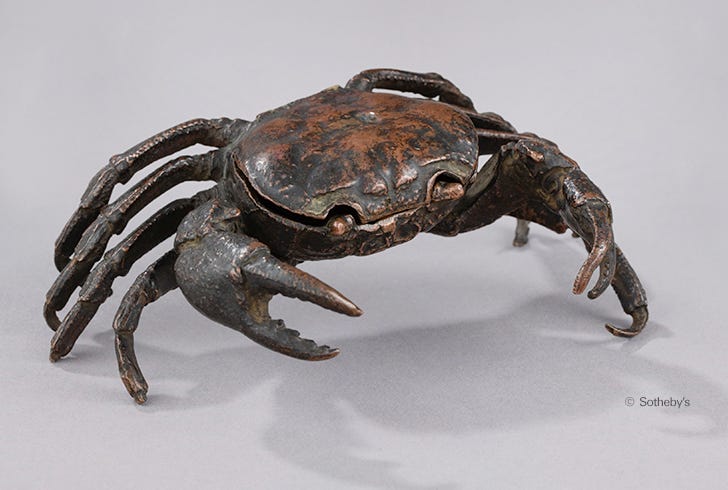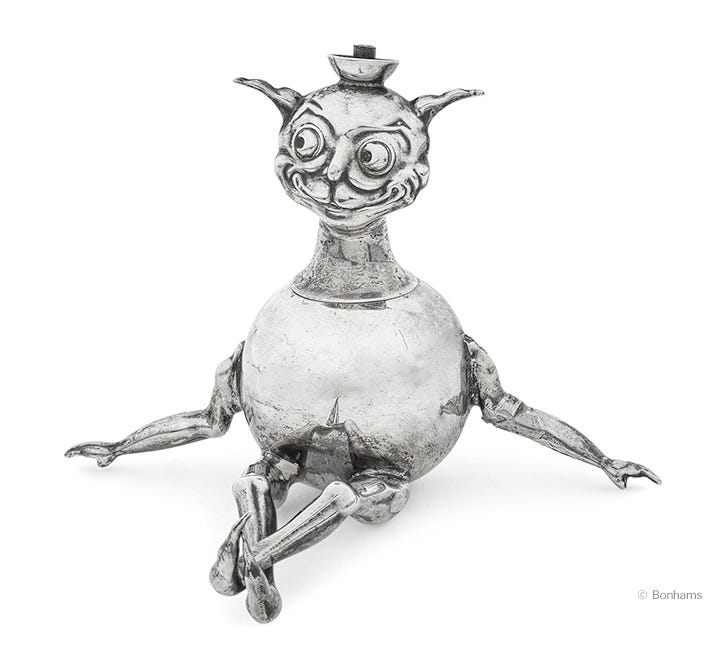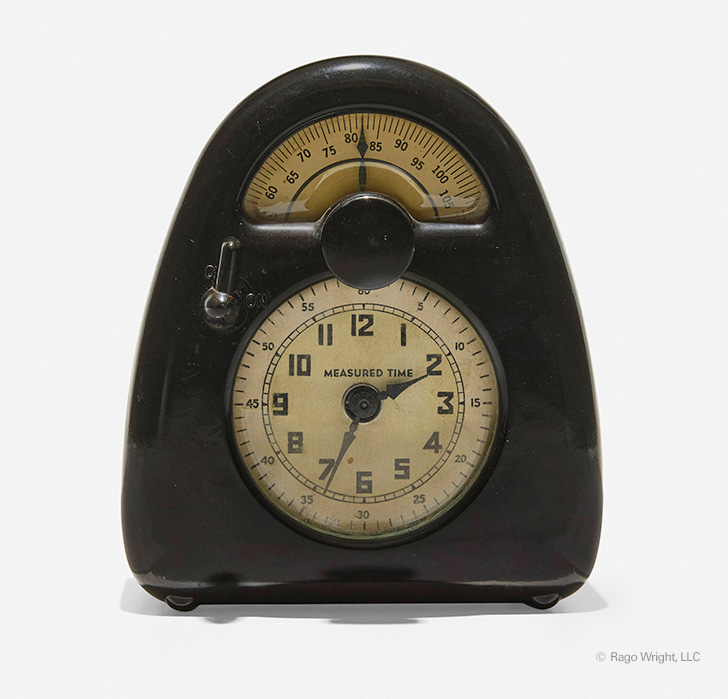Hi all. Apologies — I know this is supposed to be a newsletter about antique jewelry, but, uhhhh, not this time? We’re in a bit of a decorative arts bubble at the mo. So this time around we’re going to be looking at some weird little guys, a truly spectacular vase and then hopping into the royal carriage from The Crown to swing by Elton’s place in Atlanta.
Let’s get the spectacular out of the way first. The picture doesn’t even remotely do it justice, but this is The Hope Cup, a 1855 gold, enamel and hardstone vase made by the goldsmith Jean-Valentin Morel as a commission for the “fabulously wealthy” London banker Henry Thomas Hope (of the curséd diamond Hopes, don’tcha know). It depicts the Greek mythological story of Perseus and Andromeda in exhausting detail, and Sotheby’s has put together a nice little video that decodes the drama and gives us some great closeups:
The cup was created from an 80lb block of jasper — the cutting alone took three years — and the finished piece deservedly won the grand medal at the 1855 Exposition Universelle in Paris. It’s going up for sale in the live auction The One at Sotheby’s New York on Friday, and it’s estimated to fetch $1,800,000 - $2,500,000.
Now that that’s out of the way, I’m going to go into waaay more detail about a metal crab, because this is my newsletter and I will do what I want.
So, remember a while back I told you about how, back in the 1500s, bronze creatures were all the rage in Padua, Italy? Snakes, lizards, crayfish, shells and mythological creatures (like the sea monster I wrote about previously) were cast in bronze and sold for display or for use as functional desk items. The foundries in Northern Italy created realistic bronzes like the crab above by making casts from the crustaceans themselves — packing clay around the (dead) body and then baking it until the natural material had burned away and left a detailed mold behind.
Crabs were particularly useful as functional desk ornaments because of their shape — the shells were easily hinged, and the bodies an ideal container for the fine sand used by Renaissance scribes to soak up ink. They often would come as part of a set, with different designs serving as inkwells, pen holders etc.
So that’s all interesting and whatever, but the early 16th century Paduan crab above — which failed to sell at Christie’s Paris in 2020, where it was labeled as a 19th century Meiji period bronze from Japan — caught my eye because of its provenance. This is just the first few bits:
Francis II of Habsburg (1768–1835), Holy Roman Emperor (1792–1806), Archduke of Austria (1804–1835);
Thence by descent to his son Ferdinand I of Habsburg (1793–1875), Emperor of Austria (1835–1848);
Thence by inheritance to his nephew, Franz Joseph I of Habsburg (1830–1916), Emperor of Austria, King of Hungary, of Croatia and of Bohemia (1848–1916)
Three emperors! That’s a lot of emperors.
We don’t know how the crab first made it into the Imperial Habsburg collection (although Sotheby’s doesn’t mind speculating about Archduke Ferdinand II [1529-1595] in the lot notes), but we do know that during the second half of the 19th century, it was housed in Vienna’s Lower Belvedere Palace along with the rest of the Imperial Collections. It was later moved in 1891 to the Kunsthistorisches Museum, where it stayed until 1923, when the museum traded it to a dealer — along with three other bronzes — for a bronze relief of the Miracle of St Agnes by Alessandro Algardi.
The crab was then bought by and passed through three generations of the Cormier-Thierry-Delanoue family before ending up at Christie’s Paris in a group lot with two other bronze animals — a turtle and a buffalo — all labeled Meiji. I tracked down the auction, but it looks like the lot was pulled from display because it didn’t sell.
The piece — again labeled Meiji — then resurfaced and sold the following year for €2,060 at the Thierry de Maigret auction house in Paris. (Side note: I’m not going to cast any stones about mislabeling, because 1. mistakes happen, and 2. I have no doubt auction house employees are being worked into an early grave just like the rest of us.)
It seems Sotheby’s was able to shuck off that Meiji label because somebody spotted a four-digit red inventory number (5905) on the inside of the crab’s shell that matches the well-documented inventory of the Habsburg collection. There were originally six crabs in the collection and, going by number, it’s likely this is one of the first three they acquired. The other two — 5902 and 5909 — are still in the Kunsthistorisches Museum.
The crab is being sold in the Master Sculpture & Works of Art live auction at Sotheby’s New York on February 2, and it’s estimated at $25,000 - $35,000.
You guys know I’m a sucker for anything in a purpose-made box, so this ca. 1815 table cabinet containing various specimens of marble and hardstones is 100% my deal.
According to Christie’s, the box was “presumably made for a collector of marble specimens, or possibly a sample box for a cabinet-maker,” and the specimens inside include slabs of malachite, alabaster, yellow marble (Giallo Antico) and Sicilian jasper. The box itself is also gorgeous — it’s made of oak and burr-elm with an inlay of ebony, and is attributed to George Bullock, one of the most innovative and sought-after cabinetmakers of the Regency period.
The piece is included in the Philip Hewat-Jaboor: An Eye for the Magnificent auction at Christie’s London on February 8th and is estimated to sell for £6,000 – £10,000 ($7,600 - $12,700).
Next Wednesday, props from the phenomenally popular Netflix show The Crown will go on the block at Bonhams London in the live The Crown Auction, with The Crown Auction Online following from February 8-11. So if you want a reproduction of Diana’s ring, a kaftan worn by Helena Bonham Carter as Princess Margaret, or a selection of seven wicker dog beds, get ready.
But clearly what EVERYONE needs is a replica of the Gold State Coach built in 1762 for King George III. The prop was constructed by two companies: Devil's Horsemen, who built the chassis, and Anarchy Ltd, who were responsible for the body. According to the lot notes, it was not a simple project:
A highly experienced prop-making, model-making and special-effects company, Anarchy began by carrying out an inspection of the real Gold State Coach. From photographs taken they drew up the carriage and CNC machined a wooden jig for The Devil's Horsemen to build the wheels and chassis. With some artistic license, Anarchy used a combination of 3D CNC machining, hand sculpting in clay, and 3D printing to produce the components. Hand-sculpted elements were moulded and cast in GRP (glassfibre). Anarchy also fabricated offset steel hinges and cast brass handles featuring lion's head details to tie in with the carvings on the main body. Completed in 2019, the carriage was then used in production of The Crown.
The carriage is estimated at £30,000 - £50,000 ($38,000 - $63,000).
The other big auction event on deck is The Collection of Sir Elton John: Goodbye Peachtree Road at Christie’s New York. The lots — EIGHT auctions-worth of them — have mainly been drawn from the Atlanta home John and his partner David Furnish lived in for the past 30 years. (He sold the place last year, after he retired from touring.) The series of sales — two live auctions and six online — will take place from February 8 through February 28, and I beg you to please click the link above to see the full group, because I’m definitely not typing all that out.
It’s an eclectic mix, of course. There are platform boots, a Bentley convertible and a green Baroque wig that I frankly covet, but the standout of all the sales is the photography. According to Christie’s, John started collecting photography in earnest in the 1990s after he got sober, and he operated on the masterpiece level, amassing some of the most iconic and recognizable photos from the likes of Richard Avedon, Horst P. Horst and Irving Penn. A rare variation of Avedon’s famous Dovima with Elephants, 1955 is one of the sale’s blockbuster lots, featuring a landscape composition and a different Dior dress than shown in the better-known vertical version. It’s estimated at $100,000-$150,000. (There’s more on the photography collection here, along with some photos that give us a tiny glimpse into how John displayed some of his collection in the Peachtree home.)
As for the jewelry…this is Elton John, so obviously there’s a lot of big gaudy gold and diamond stuff from major names — Cartier, Versace, Kieselstein-Cord, etc. — but also from contemporary London designers like Stephen Webster and LOTS of Theo Fennell (who I suppose should now also be namechecked as the father of Saltburn writer/director Emerald Fennell). I snorted at the Fennell pendant in one of the sales that features a single diamond-set cursive word within a diamond circle, because Christie’s refuses to state that it says “arsehole.”
There’s not much particularly OLD stuff, jewelry-wise, but I did spot this ca. 1915 amethyst and gold cross necklace by 15th-generation French jewelers Mellerio, and also this garnet, diamond and enamel pendant, which looks like a 19th century Holbeinesque piece but has very little accompanying info. And of course there are plenty of super expensive pieces to cover, but I’m going to focus on the aluminum rocket cufflinks above instead, because they’re adorable, and again, my newsletter etc. They carry an estimate of $2,500 – $3,500 and were made by Deakin & Francis, a 7th-generation family jewelry business founded in Birmingham, England back in 1786 (and they’re still based in the same factory!)
Deakin & Francis are renowned for their massive selection of cufflinks, and in fact those rockets are $570 if you aren’t interested in the fancy provenance. Also — Christie’s didn’t mention this, but if you pull the little lever on the side of each cufflink, it shoots out those enameled golden flames.
This little silver imp is actually a lighter, and Bonhams London think he might be based on the character Psammead, a wish-granting sand-fairy featured in a trilogy of children’s books — the first is Five Children and It — by The Railway Children author E. Nesbit. Wikipedia gives us a quick rundown on the little guy:
…Five children find the Psammead in a gravel pit, which used to be seashore. There were once many Psammeads, but the others died when they got wet and caught cold. It is the last of its kind. It is thousands of years old, and remembers pterodactyls and other ancient creatures.
The piece is tentatively attributed to silversmith Charles Edwin Turner, Birmingham 1911, and features a removable head and a spherical body with outstretched arms and crossed legs. He’s estimated at £600 - £800 ($760 - $1,000), and is included in the live auction The Connoisseur's Library Sale, taking place on February 13-14 at Bonhams London.
Just fyi: that’s a delightful auction to browse, with 901 lots including such randomness as a set of late 19th/early 20th century carved wood truncheons, a bright orange guilloché enamel and diamond cigarette case by Fabergé, and a relic dating back the days we used to hide our porn in owls.
Included in the February 8th American Design auction at Wright Chicago is this unassuming little ca. 1932 Measured Time clock and kitchen timer. Cool thing is, it was designed by legendary sculptor Isamu Noguchi.
During the Depression, Noguchi’s large-scale public art proposals were a no-go, so instead, according to the Isamu Noguchi Foundation and Museum, “he channeled his energy into rethinking the design of everyday life.” Among a billion other things, he designed cases for clocks and baby monitors, invented a lighted musical weathervane, and racked up a whole bunch of patents. And according to Wright, this little clock/kitchen timer was the first of Noguchi’s designs to go into mass production. It’s made of Bakelite, glass, printed paper and enameled brass, and was produced by the Stevenson Mfg. Co. Estimate: $1,000 - $1,500.
That has to be it for today, because the ridiculous amount of links I’ve larded in here is putting me over the size limit. I do want to shout out one thing, though: Starting Friday, the brilliant ladies of Drinks with Broads are going to be recapping the anthology series Feud: Capote vs. The Swans, which debuts on FX tonight (and on Hulu tomorrow). I seriously haven’t been this jazzed about anything in ages. Both show and recaps! Feud focuses on writer Truman Capote’s close friendships with (and betrayal of) many of the highest-of-the-high society New York women of the 1960s, and it’s got a killer cast including Naomi Watts, Diane Lane and Demi Moore. Calista Flockhart as Lee Radziwill! I highly recommend signing up for a paid sub to join the fun.
Ok that’s it. Love you guys! Take care of yourselves. M xx











I love the crab and the Psammead (and have read those books). How to choose??
The Hope Cup but re-done with Muppets